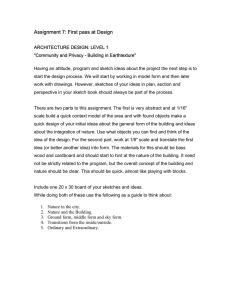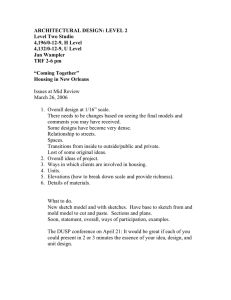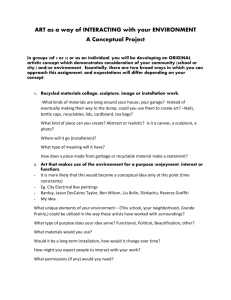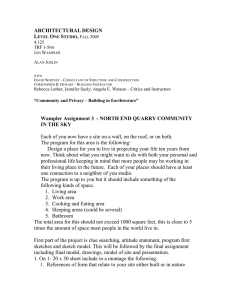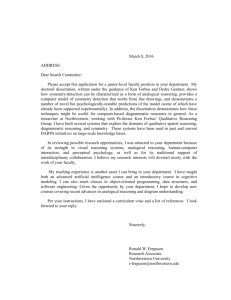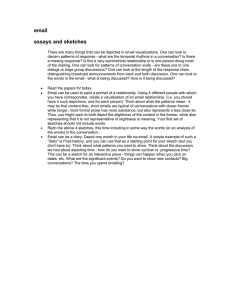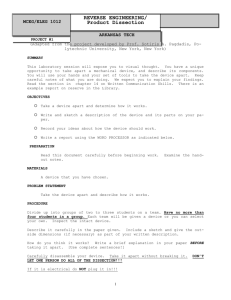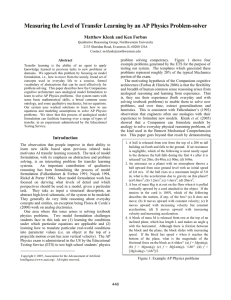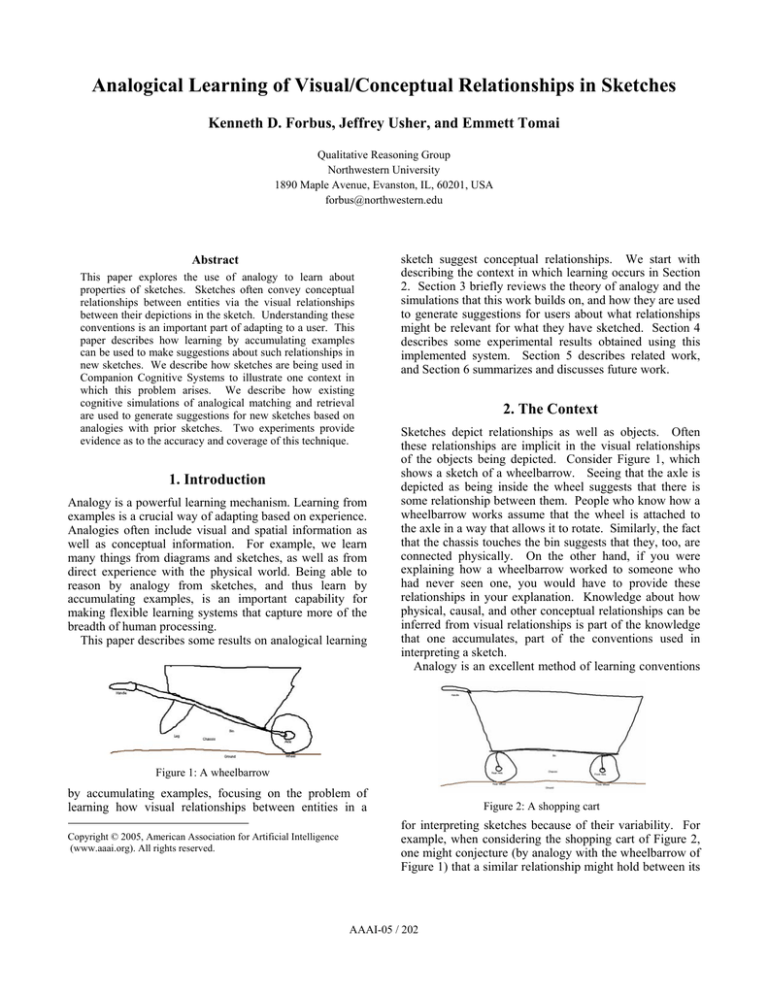
Analogical Learning of Visual/Conceptual Relationships in Sketches
Kenneth D. Forbus, Jeffrey Usher, and Emmett Tomai
Qualitative Reasoning Group
Northwestern University
1890 Maple Avenue, Evanston, IL, 60201, USA
forbus@northwestern.edu
Abstract1
This paper explores the use of analogy to learn about
properties of sketches. Sketches often convey conceptual
relationships between entities via the visual relationships
between their depictions in the sketch. Understanding these
conventions is an important part of adapting to a user. This
paper describes how learning by accumulating examples
can be used to make suggestions about such relationships in
new sketches. We describe how sketches are being used in
Companion Cognitive Systems to illustrate one context in
which this problem arises. We describe how existing
cognitive simulations of analogical matching and retrieval
are used to generate suggestions for new sketches based on
analogies with prior sketches. Two experiments provide
evidence as to the accuracy and coverage of this technique.
1. Introduction
Analogy is a powerful learning mechanism. Learning from
examples is a crucial way of adapting based on experience.
Analogies often include visual and spatial information as
well as conceptual information. For example, we learn
many things from diagrams and sketches, as well as from
direct experience with the physical world. Being able to
reason by analogy from sketches, and thus learn by
accumulating examples, is an important capability for
making flexible learning systems that capture more of the
breadth of human processing.
This paper describes some results on analogical learning
sketch suggest conceptual relationships. We start with
describing the context in which learning occurs in Section
2. Section 3 briefly reviews the theory of analogy and the
simulations that this work builds on, and how they are used
to generate suggestions for users about what relationships
might be relevant for what they have sketched. Section 4
describes some experimental results obtained using this
implemented system. Section 5 describes related work,
and Section 6 summarizes and discusses future work.
2. The Context
Sketches depict relationships as well as objects. Often
these relationships are implicit in the visual relationships
of the objects being depicted. Consider Figure 1, which
shows a sketch of a wheelbarrow. Seeing that the axle is
depicted as being inside the wheel suggests that there is
some relationship between them. People who know how a
wheelbarrow works assume that the wheel is attached to
the axle in a way that allows it to rotate. Similarly, the fact
that the chassis touches the bin suggests that they, too, are
connected physically. On the other hand, if you were
explaining how a wheelbarrow worked to someone who
had never seen one, you would have to provide these
relationships in your explanation. Knowledge about how
physical, causal, and other conceptual relationships can be
inferred from visual relationships is part of the knowledge
that one accumulates, part of the conventions used in
interpreting a sketch.
Analogy is an excellent method of learning conventions
Figure 1: A wheelbarrow
by accumulating examples, focusing on the problem of
learning how visual relationships between entities in a
Copyright © 2005, American Association for Artificial Intelligence
(www.aaai.org). All rights reserved.
Figure 2: A shopping cart
for interpreting sketches because of their variability. For
example, when considering the shopping cart of Figure 2,
one might conjecture (by analogy with the wheelbarrow of
Figure 1) that a similar relationship might hold between its
AAAI-05 / 202
wheels and axles.
Some conventions are highly
formalized, standardized, and used in a uniform way across
an entire community of practice. Other conventions are
short-lived and ad hoc, introduced for, and used only
within, a single conversation. Groups working together
even for a short time often evolve local conventions
(Markman & Makin, 1998).
Thus learning by
accumulating examples seems to be a natural way to adapt
to changing circumstances.
The experimental setting we use to explore this task
involves using sketching to learn to solve problems, as part
research on a new cognitive architecture, Companion
cognitive systems (Forbus & Hinrichs, 2004).
Companions are intended to work with, and learn from,
human collaborators. The major learning mechanism used
in Companions is analogy, exploring the conjecture
(Forbus & Gentner, 1997) that analogical reasoning is
crucial to the flexibility and breadth of human common
sense reasoning and learning. One of the domains being
explored is learning everyday physical reasoning, using the
kinds of questions that are found on the Bennett
Mechanical Comprehension Test (BMCT), an examination
used for over 50 years to classify candidates for technical
jobs and also by cognitive psychologists as an independent
measure of spatial ability. Problems on this test are posed
in the form of diagrams, making it perfect for sketched
input.
The sketching Knowledge Entry Associate (sKEA,
Forbus & Usher, 2002) is used to handle user interaction
via sketching for these problems. sKEA is the first opendomain sketch understanding system.
It provides
conceptual labeling facilities in its interface that avoid the
reliance on recognition that limits other sketching systems
to tightly circumscribed domains (cf. Cohen et al 1997;
Alvarado & Davis, 2001). Anything that can be described
in terms of sKEA's knowledge base can be used in a
sketch. sKEA's knowledge base consists of a 1.2 million
fact subset of Cycorp's Cyc KB1, which includes over
38,000 concepts, over 8,000 relations, and over 5,000
logical functions. We have added to that our own
representations of qualitative physics, visual properties and
relationships, spatial knowledge, and representations to
support analogical reasoning, but the vast majority of the
content that we deal with was independently developed.
sKEA enables users to fill in information about
visual/conceptual relationships as they sketch, using a
hypertext form. As described elsewhere, sKEA computes
qualitative topological relationships as part of its visual
processing, using Cohn's (1996) RCC8 vocabulary. When
sKEA finds two glyphs that are either touching (PO or EC,
in RCC8) it asserts a very high-level relationship,
atOrOverlapsInSketch, between the two entities depicted
by those glyphs. Similarly, when one glyph is inside
another (TPP or NTPP), it asserts insideInSketch
1
The conventions used in this KB are documented at
www.opencyc.org, although our KB includes a larger subset of
Cyc than OpenCyc does.
between the entities depicted. These two relationships
form the bridge between the visual properties of the sketch
and the conceptual understanding of what is depicted.
atOrOverlapsInSketch and insideInSketch are tied into
the rest of the KB by asserting genlPreds statements that
link them into the relationship lattice. (Like most KB's, the
Cyc KB organizes predicates into a generalization lattice.
The relation (genlPreds <subPred> <superPred>)
indicates that the relationship <superPred> is a
generalization of the relationship <subPred>, in that
whenever <subPred> holds for a collection of entities, that
implies <superPred> holds of them as well.) Specifically,
atOrOverlapsInSketch is asserted to be a generalization
of aligned, touches, and connectedTo. These predicates
in turn have more specialized versions, leading to a total of
204 potential ways to specialize atOrOverlapsInSketch.
Not all of these specializations are relevant to every
situation. For example, there are type restrictions placed
on the arguments to every relationship, using the 38,000+
collections defined in the KB. For example, over 60
collections are used to restrict the arguments to the
specializations of atOrOverlapsInSketch, ranging from
the very general (e.g., SpatialThing) to the very specific
(e.g., City, Nucleotide). Similarly, insideInSketch is a
direct generalization of inRegion and spatiallyIncludes,
which lead to a total of 150 distinct specializations that can
be chosen, with a similar variation in argument type
restrictions.
When sKEA's visual system asserts one of these bridge
relationships, the system considers what more concrete
relationships might make sense in this situation. The
initial candidate set is generated by considering all
specializations via a query (e.g., (genlPreds ?r
insideInSketch)), and eliminates those relationships
whose argument type restrictions are not satisfied by what
is currently known about the entities depicted. The
remaining candidates are then presented to the user, who is
invited to select one or more of them as appropriate for
that pair of entities. There tend to be a lot of candidates: In
the worst case, there are 150 specializations of
insideInSketch, and 204 for atOrOverlapsInSketch.
Figure 3: Using analogy to suggest a relationship
In Companions, this sKEA-level mechanism is
augmented by analogy, to attempt to make things easier for
the user. This is a worthwhile problem since the number
of candidates is so large: In one corpus, there were on
average of four such questions per sketch, with an average
of 122 candidates to consider per question. We use
analogy to suggest relationships that they used previously
in a prior similar sketch. Figure 3 illustrates one such
suggestion for the shopping cart of Figure 2, given the
AAAI-05 / 203
retrieved analog of the wheelbarrow of Figure 1. (In this
case, there were 109 candidate relationships.) The ? button
enables users to see why this particular suggestion was
made, and the A button lists the assumptions underlying
the suggestion.
3. The Analogical Learning Model
Here we describe how the analogical reasoning is carried
out, starting with a brief review of structure-mapping and
associated simulations to provide context.
3.1 Brief review of Structure-Mapping
The approach we use is based on Gentner's (1983)
structure-mapping theory.
Structure-mapping defines
analogy and similarity in terms of comparisons involving
structured representations, the base and the target. The
matching process produces mappings, which consist of
three parts. The correspondences of a mapping describe
"what goes with what", e.g., how items in the base (entities
and statements) align with items in the target. The
structural evaluation score of a mapping is an expression
of overall match quality. The candidate inferences of a
mapping are surmises about the target, given the
correspondences and other structure in the base. That is,
they are projections of non-matched base structure that is
suggested by the match into the target. Candidate
inferences sometimes introduce new entities into the target,
when they mention an entity for which there is no known
correspondent in the target. These new entities are called
analogy skolems. The principles that govern the mappings
people compute are described in (Gentner, 1983).
There is now considerable empirical support for
structure-mapping theory as a model of human analogy
and similarity (cf. Markman & Gentner, 2000). Moreover,
this theory has guided the development of cognitive
simulations of analogical processing. Two of these
simulations, used in this system, are SME (Falkenhainer et
al 1986) and MAC/FAC (Forbus et al 1994b). SME
models analogical matching. It operates in polynomial
time, using a greedy merge algorithm to compute up to
three alternate mappings, which can be extended
incrementally as new information is provided (Forbus et al
1994a). MAC/FAC models similarity-based retrieval. The
first stage (MAC) uses a special-purpose feature vector
representation that is automatically constructed from
structured descriptions, so that the dot product of two
vectors is an estimate of the score that SME would
compute for the best possible mapping from them. This
provides a scalable first stage filter, operating in parallel
over a case library, that provides the best cases (up to
three) for consideration in the second stage. The second
stage (FAC) uses SME to compare the structured
descriptions for each MAC candidate against the probe.
The best reminding (or up to three, if they are very close)
are returned.
Both SME and MAC/FAC have been used to
successfully model a variety of psychological findings, and
have been used to make predictions that have been
subsequently borne out in psychological experiments
(Forbus, 2001). Moreover, they have both been used in
performance systems (ibid.). This makes them suitable for
use in this task, since the notion of similarity used in
Companions needs to be compatible with their users'
notion of similarity.
Interactions between analogical processing and firstprinciples reasoning are handled using an analogy
ontology (Forbus et al 2002), which provides relationships
that are implemented via procedural attachment to SME
and MAC/FAC, enabling them to be run and their results
inspected as simply another kind of inference. In addition
to specifying cases by explicitly storing sets of facts, cases
can be constructed dynamically from the knowledge base,
or existing cases can be filtered for particular purposes
(Mostek et al 2000).
3.2 Baseline analogical learning model
Human analogical learning is extremely flexible. It is
important when studying a complex phenomenon to
establish a baseline, a model that is easily understood and
against which the gain provided by specific improvements
can be measured. In Companions the baseline analogical
learning method used is example-based, since we can then
later measure how much improvement is provided by
models of analogical generalization (e.g., SEQL (Kuehne
et al 2000)). Given a problem, we use MAC/FAC to
produce a set of remindings. The candidate inferences
provided by these remindings are then inspected for
information relevant to the problem at hand. There is
evidence that people will attempt to find other remindings
when their first set is insufficient, and that they will try
alternate mappings when the first does not work out. We
use neither of those techniques here; whatever suggestions
are provided by the first remindings are the only answers
provided.
3.3 Generating visual/conceptual relationship
suggestions via analogy
Given a library of prior sketches stored in the knowledge
(CaseLibraryFn
sKEA-VCMbase
(denoted
by
CaseLibrary)),
the visual/conceptual relationships
interface looks for suggestions based on prior experience
by using this Prolog-style rule:
AAAI-05 / 204
(<== (analogySuggestionFor
(visualInterpretationRelationSuggestion
?reln ?o1 ?o2)
?probe ?mapping)
;; Get reminding(s) based on the whole thing
(reminding ?probe
(CaseLibraryFn sKEA-VCM-CaseLibrary)
?case ?original-match)
;; Focus only on conceptual knowledge
(matchBetween ?case
(ConceptualFactsOfCaseFn ?probe)
(TheSet) ?match)
(bestMapping ?match ?mapping)
;; Find relevant candidate inferences
(candidateInferenceOf ?ci ?mapping)
(candidateInferenceContent ?ci ?formula)
(unifies
(userAcceptsBinaryRelationSuggestion
(AnalogySkolemFn ?reln) ?o1 ?o2)
?formula)
;; Possibly relevant, but might it be valid?
;; See if it has been made as a suggestion.
(visualInterpretationRelationSuggestion
?reln ?o1 ?o2)
;; Last two improve the explanations
(correspondsInMapping ?mapping ?bo1 ?o1)
(correspondsInMapping ?mapping ?bo2 ?o2))
Here ?probe is the current sketch, with ?reln being the
relationship suggested between entities ?o1 and ?o2. The
reminding query causes MAC/FAC to be run, using the
entire set of information about the sketch to find
potentially relevant prior sketches. This term provides a
set of bindings for each reminding, with ?case being the
prior example and ?original-match being the comparison
of the prior example with the current sketch.
While appearance information is useful in finding
relevant precedents, we found through experimentation
that focusing only on conceptual information led to better
candidate inferences. The reason is that conceptual
information (i.e., the categories of the entities) is crucial to
accurate candidate inferences, but it can be overwhelmed
by the larger quantity of visual information. Therefore
instead of simply using the match constructed by
MAC/FAC, we match the remindings against just the
conceptual facts of the sketch. This is done by the
matchBetween term of the query, which invokes SME
directly. The user’s current sketch is filtered using the
case constructor ConceptualFactsOfCaseFn, which
removes any facts that mention glyphs from the case.
Importantly, spatial relationships between entities that
were inferred as a consequence of visual relationships
between glyphs remain as part of the case. It is only the
glyphs themselves and their properties that are removed.
The third argument to matchBetween is the set of
constraints under which the mapping is to be done (here,
empty), and the results are bound to ?match.
The bestMapping term extracts the best mapping from
the match. SME produces up to three alternate mappings,
if the descriptions warrant, but we only use the best one
here. The next three terms in the rule identify relevant
candidate inferences, by finding suggestions that the user
accepted in the retrieved sketch. Notice the use of ?o1 and
?o2 in the inference content, versus (AnalogySkolemFn
?reln) for the relation. We want ?o1 and ?o2 to be
constrained by the mapping, otherwise we cannot tell to
what the relationship is being applied to. On the other
hand, ?reln isn't aligned in the mapping, so it will be
treated as an individual hypothesized to exist in the target.
This is a simple case of skolem resolution, an important
problem in analogical reasoning. While skolem resolution
in general can require sophisticated constraint solving (cf.
(Forbus et al 2003)), here we simply import the exact same
relationship by using the value of ?reln without further
processing.
Recall that candidate inferences are not necessarily
valid; to check that this suggestion is in fact valid, we
exploit the reasoning done by the standard
visual/conceptual relationship suggestion generation
routines, looking to see if this suggestion was in fact
among those generated. If it is, then it must be valid, and
otherwise, it cannot be, since that inference process is
complete. The last two terms of the query are not needed
to generate suggestions. Their purpose is to make
explanations more understandable, by making explicit
which entities in the retrieved sketch were used in creating
the suggestion.
The retrieved suggestions are displayed as illustrated in
Figure 2. Since MAC/FAC can produce between zero and
three remindings, this process can produce multiple
suggestions for the same pair of entities, due to different
remindings. When multiple suggestions are generated for
the same relationship, all are displayed for the user.
4. Experiments
We carried out two experiments with this system to
evaluate its performance. We describe each in turn.
4.1 Visual/Conceptual Relations in Problem
Solving
The first experiment used sketches generated as part of a
larger experiment, where Companion software was tested
against 13 problems drawn from the BMCT1. Three
graduate students acting as knowledge enterers (KEs) drew
18 sketches, each specified by a phrase (e.g., “A crane
lifting a load”, “A wheelbarrow, with a rock in it.”). Their
goal was to provide a causal explanation for whatever
principle(s) they thought applied in that situation. As part
of the sketching process, they specified collections and
relationships so that when the system’s qualitative
reasoning facilities were applied, the appropriate model
fragments would be instantiated. The starting endowment
of qualitative knowledge for the system is qualitative
mechanics (Kim, 1993; Nielsen 1988) and the ontology of
qualitative process theory (Forbus, 1984). They could also
annotate the sketch with additional, situation-specific
causal information, using a concept map system linked to
sKEA. For example, they could specify that the stability
1
This is roughly 19% of the exam.
AAAI-05 / 205
of a ladder was qualitatively proportional to the width of
its base, using the sketch to indicate what they meant by
the width of the base, and the concept map to introduce the
stability parameter and the qualitative relationship. The
visual/conceptual relationship interface was used to enter
some of the relationships needed for appropriate
qualitative modeling. KEs were encouraged to answer as
many visual/conceptual relationship questions as possible.
The sketches were then used as a case library to solve
problems specified via sketches drawn by a fourth
graduate student, as described in (Klenk et al 2005).
We used the library of 54 sketches from that experiment
to investigate the performance of the visual/conceptual
relationship suggestions method described in Section 3.
Our method was to draw each case out of the library in
turn, filter out the answers to its visual/conceptual
relationship questions, and use the other 53 cases to make
suggestions about it. This “round robin” strategy yielded
181 visual/conceptual relationship questions which the
KEs had answered, and thus against which we could test
the generation of suggestions via analogy. We scored
answers using the following rubric: If the suggestion had
the correct relationship and the arguments in the right
order, it received a score of 1.0. If the arguments were
flipped (and the relationship wasn’t symmetric), it received
a score of 0.5, on the grounds that it is easier to recognize
that arguments need to be reversed than to find the right
relationship out of over a hundred candidates. Similarly, if
the predicate is one step away from the correct relationship
within the genlPreds lattice, we give it a score of 0.5, and
within two of the correct relationship, a score of 0.25,
since these are still in a usefully close neighborhood of the
correct answer. Any other answer is scored 0.0.
This is a harsh scoring rubric: The expected value for
the 181 questions is just 24.2, if relationships from the set
of suggestions were picked at random1. Importantly, the
system’s score on these questions was much better, 74.25.
This is statistically significant (P << 10-5), indicating that
the system is providing very reasonable suggestions. Is
this due to partial credit? Not really: The score for 64
questions was 1.0, the score for 19 questions was 0.5, and
only three questions were scored at 0.25.
The coverage of the system is a weak point. We define
coverage as the ratio of the number of problems where the
system provides an answer to the number of problems. It
tackled only 97 out of the 181 problems (54% coverage),
but was able to provide reasonable answers for 86 of those
97 (87%). Given the baseline analogical model described
above, the limitation in coverage is not too surprising.
Consider
again
the
wheelbarrow-shopping
cart
comparison.
The wheel/axle combination of the
wheelbarrow could in principle be used to make
suggestions about both the front and rear wheels and axles
of the shopping cart, but because mappings must be 1:1
and we are only working with a single mapping, a
1
For accuracy, we explicitly calculated the distribution of possible
scores, rather than relying on an approximation.
suggestion is made about only one of them. Examining
multiple mappings, and even remapping to aggressively
generate additional hypotheses by specifying additional
match constraints, for example, might significantly expand
coverage.
4.2 Open-ended tasking
One possible explanation for the good performance above
is that the constraint of generating qualitative models
might have simplified the task, since relationships that
allowed the system to infer qualitative models were
preferred. To rule out this explanation, it is useful to look
at a similar situation where no such restrictions were
imposed. A list of ten entities drawn from the BMCT was
selected at random, covering a larger range of phenomena
than the experiment above (e.g., “a boat moving in water”,
“a bicycle”). Two graduate students sketched each system,
being told only that they should draw them in enough
detail to illustrate what they thought were the relevant
principles in their operation.
The students were
encouraged to answer as many of the visual/conceptual
relationships that the system asked as they could, but only
when they were sure of the answers. Again, the roundrobin methodology was used, drawing each case in turn
out of the library of twenty cases, stripping the user
choices from it and using the other 19 cases to construct
suggestions for its visual/conceptual relationships via
analogy. This yielded a set of 138 questions.
The system generated suggestions for 63 out of the 138
questions (46% coverage). Using the same scoring rubric
as the first experiment, the system’s score was 21.75,
which is statistically significant (P < 10-7). Unlike the
previous experiment, where the system nailed the correct
relationship most of the time, here partial credit was very
important: It only suggested the exact relationship 6 times,
or 10% of the time. However, the overall accuracy of the
system is still quite reasonable. Interestingly, there is a
small drop in coverage (46% versus 54%), but this is still
quite respectable.
5. Related Work
Some have argued (cf. Davies & Goel, 2001, 2003) that
visual analogy requires special-purpose mechanisms.
Their Galatea model uses a hand-crafted special-purpose
ontology, and appears to have only been tested with a few
examples. By contrast, the system described here draws
upon off-the-shelf cognitive simulations and an
independently-derived large knowledge base, using only a
few new relationships to provide a bridge between visual
and conceptual information. In this regard our work is
more like Ferguson’s (1994; Ferguson & Forbus 2000),
which uses representations and processing models inspired
by psychological results whenever available, and off-theshelf components and representations otherwise.
AAAI-05 / 206
Competing cognitive simulations of analogical
processing mostly fall into two categories. Domainspecific models (e.g., Mitchell, 1993; French 1995) are
hard-wired in their matching and representation
construction to work only in a pre-defined microworld, and
hence are inapplicable to the kinds of problems tackled
here. Connectionist simulations (cf. Eliasmith & Thagard,
2001; Hummel & Holyoak, 1997; Larkey & Love, 2003)
attempt to explain how similar computations can be
expressed given assumptions about neural hardware.
Unfortunately, all of these schemes to date are limited to
very small descriptions, typically 2-3 relations, and cannot
to scale to the size of descriptions used here (i.e., sketches
involve hundreds of propositions). We know of no other
existing simulations of analogical mapping or retrieval that
have been successfully tested with the number of domains
and with the size of examples (and size of case libraries)
that SME and MAC/FAC have been used with.
Case-based reasoning systems (cf. Kolodner 1994;
Leake 1996) tend to use special-purpose matchers and
memory indexing systems.
By contrast, SME and
MAC/FAC operate in multiple domains, and MAC/FAC
does not require any indexing, which simplifies the
incorporation of new examples into memory.
selecting something it should have retrieved, using a
sketch browsing interface to scan the case library). This
feedback will then be used to help the system improve its
methods for encoding sketches, and thus facilitate future
retrievals and mappings.
6. Future Work
Cohn, A.G. 1996 Calculi for Qualitative Spatial
Reasoning. In Calmet, J., Campbell, J.A., and Pfalzgraph,
J. (Eds.) Artificial Intelligence and Symbolic Mathematical
Computation. LNCS 1138. Springer Verlag, 124-143.
We have shown that an important kind of knowledge about
sketches, conventions for interpreting visual relationships
between elements of a sketch to suggest conceptual
representations between the entities depicted, can be
learned by accumulating examples and reasoning by
analogy over those examples. This is a hard problem, as
illustrated by the number of possible relationships that
participants in sketching must consider when providing
answers. The ability for a straightforward analogical
reasoning process, using off-the-shelf cognitive simulation
models, to handle this task is very encouraging.
This work raises a number of interesting lines of future
investigation. First, we know from cognitive psychology
that there are a variety of ways that people use analogy in
solving similar problems that are not captured by our
baseline model. These include using rerepresentation
(Yan et al 2003) to improve alignment of retrieved cases,
using multiple mappings on a single problem, and
retrieving additional cases as the problem representation is
augmented. We plan on implementing all of these, and
measure quantitatively how much each of them improves
coverage and accuracy over the baseline model described
here. Second, we plan on experimenting with SEQL
(Kuehne et al 2000), a model of generalization based on
analogical processing of structured representations, to
refine examples into more abstract, rule-like descriptions,
to see if that improves learning. Third, the experiments
described above were carried out off-line. We plan to do
on-line experiments, where users can give the system
feedback about its suggestions (good/bad) and about the
precedents it retrieved to generate them (including
Acknowledgements
This research was supported by the Information Processing
Technology Office of the Defense Advanced Research
Projects Agency. All opinions presented here are those of
the authors, not those of the U.S. government.
References
Alvarado, Christine and Davis, Randall (2001). Resolving
ambiguities to create a natural sketch based interface.
Proceedings of IJCAI-2001.
Cohen, P. R., Johnston, M., McGee, D., Oviatt, S.,
Pittman, J., Smith, I., Chen, L., and Clow, J. (1997).
QuickSet: Multimodal interaction for distributed
applications, Proceedings of the Fifth Annual International
Multimodal Conference (Multimedia '97), Seattle, WA,
November 1997), ACM Press, pp 31-40.
Davies, J., & Goel, A. K. (2001). Visual analogy in
problem solving. Proceedings of IJCAI 2001. pp 377-382.
Morgan Kaufmann.
Davies, J. and Goel, A. 2003. Representation issues in
visual analogy. Proceedings of CogSci03.
Eliasmith, C. and Thagard, P. 2001. Integrating structure
and meaning: A distributed model of connectionist
mapping. Cognitive Science.
Falkenhainer, B., Forbus, K. and Gentner, D. The
Structure-Mapping Engine. Proceedings of the Fifth
National Conference on Artificial Intelligence. 1986.
Ferguson, R. W. (1994). MAGI: Analogy-based encoding
using symmetry and regularity, Proceedings of CogSci94.
Ferguson, R. and Forbus, K. (2000). GeoRep: A flexible
tool for spatial representation of line drawings.
Proceedings of AAAI-2000. Austin, Texas.
Forbus, K. D. (1984). Qualitative Process Theory. Artificial Intelligence, 24, 85-168.
Forbus, K. 2001. Exploring analogy in the large. In
Gentner, D., Holyoak, K., and Kokinov, B. (Eds.)
Analogy: Perspectives from Cognitive Science. MIT Press.
Forbus, K. and Gentner, D. 1997. Qualitative mental
models: Simulations or memories? Proceedings of the
AAAI-05 / 207
Markman, A.B., & Makin, V.S. 1998. Referential
communication and category acquisition. Journal of
Experimental Psychology: General, 127, 331-354.
Eleventh International Workshop on Qualitative
Reasoning, Cortona, Italy.
Forbus, K., Ferguson, R. and Gentner, D. 1994.
Incremental structure-mapping. Proceedings of the
Cognitive Science Society, August.
Mitchell, M. (1993) Analogy-making as perception: A
computer model. MIT Press, Cambridge, MA.
Forbus, K., Gentner, D., and Law, K. MAC/FAC: A model
of similarity-based retrieval. Cognitive Science, 19, 141205. 1994.
Mostek, T., Forbus, K. and Meverden, C. 2000. Dynamic
case creation and expansion for analogical reasoning.
Proceedings of AAAI-2000. Austin, Texas.
Forbus, K. and Hinrichs, T. 2004. Companion Cognitive
Systems: A step towards human-level AI. AAAI Fall
Symposium on Achieving Human-level Intelligence
through Integrated Systems and Research, October,
Washington, DC.
Nielsen, P. 1988. A Qualitative Approach to Rigid Body
Mechanics. Ph.D. dissertation, University of Illinois at
Urbana-Champaign.
Forbus, K., Mostek, T. and Ferguson, R. 2002. An
analogy ontology for integrating analogical processing and
first-principles reasoning. Proceedings of IAAI-02, July.
Yan, J., Forbus, K. and Gentner, D. 2003. A theory of
rerepresentation in analogical matching. Proceedings of
the 25th Annual Conference of the Cognitive Science
Society
Forbus, K. and Usher, J. 2002. Sketching for knowledge
capture: A progress report. IUI’02, San Francisco, CA.
Forbus, K. Usher, J. and Chapman, V. 2003. Qualitative
spatial reasoning about sketch maps. Proceedings of
IAAI03, Acapulco, Mexico
French, R. (1995). The subtlety of similarity. Cambridge,
MA: The MIT Press.
Gentner, D., Structure-mapping: A theoretical framework
for analogy, Cognitive Science 7(2), 1983
Hummel, J.E., & Holyoak, K.J. (1997). Distributed
representations of structure: A theory of analogical access
and mapping. Psychological Review, 104.
Kim, H. 1993. Qualitative reasoning about fluids and
mechanics. Ph.D. dissertation and ILS Technical Report,
Northwestern University.
Klenk, M., Forbus, K., Tomai, E., Kim, H., and
Kyckelhahn, B. 2005. Solving Everyday Physical
Reasoning Problems by Analogy. Proceedings of AAAI05.
Kolodner, J. L. 1994. Case-based reasoning. San Mateo,
CA: Morgan Kaufmann Publishers.
Kuehne, S., Forbus, K., and Gentner, D. 2000. SEQL:
Category learning as incremental abstraction using
structure mapping. Proceedings of CogSci-2000.
Philadelphia, PA.
Larkey, L. and Love, B. 2003. CAB: Connectionist
Analogy Builder. Cognitive Science, 27:781-794.
Leake, D. (Ed.) 1996. Case-based Reasoning:
Experiences, Lessons and Future Directions, MIT Press.
Markman, A. B., & Gentner, D. 2000. Structure-mapping
in the comparison process. American Journal of
Psychology, 113(4), 501-538.
Markman, A. B., & Gentner, D. 2000. Structure-mapping
in the comparison process. American Journal of
Psychology, 113(4), 501-538.
AAAI-05 / 208

